The life of women is simply unthinkable without cosmetics. Mascara, lipstick, foundation or powder, shadows - all this is in almost every women's "cosmetic bag". But at the same time, very few representatives of the fair sex pay attention to the composition of the beauty products used, and this is extremely important knowledge.
What is included in cosmetics
Very rarely, women pay attention to the composition of cosmetics, which can be checked on the product packaging. It can contain both harmful and beneficial substances.
The standard components of cosmetics are as follows:
- Propylene glycol (improves cell regeneration, retains moisture in the skin).
- Hyaluronic acid (brightens skin pigmentation, makes it less visible, improves skin elasticity and slows down aging).
- Collagen (forms a film on the skin, clogs pores, is not perceived by the body as a useful substance).
- Glycerol (removes moisture from the lower layers of the skin to give it to the upper and dead cells).
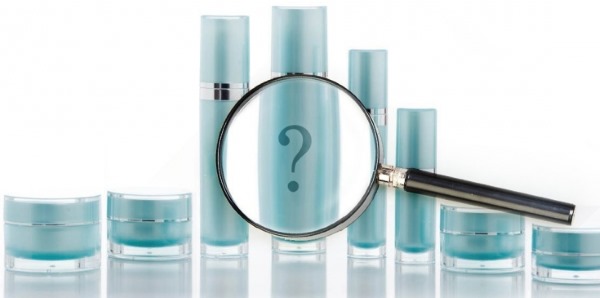
- Albumen (reduces wrinkles, makes them less visible, tightens the oval of the face).
- Fruit acid (promote skin renewal, remove dead skin particles, fight acne).
- Essential oils (jojoba oil and argan oil moisturize the skin and give it a glow).
- Zinc (normalizes the work of the sebaceous glands, makes the skin dull).
- Parabens (have a negative effect on the skin, may cause an allergic reaction).
- Royal jelly (harmless to the skin, but does not bring any benefit).
European requirements for cosmetics and prohibited ingredients in the composition
At the moment, European requirements for cosmetics are quite high. There is a special Regulation No. 1223/2009 of the European Parliament and of the Council of 30.11.2009 on cosmetic products. It states what cosmetics may include.
The main requirement of the regulation is that cosmetics must be safe, not only for consumers, but also for nature.
Much attention is paid to the composition of cosmetics, all its components must be checked for safety.
There are a number of components that cannot be used as a constituent substance of cosmetics:
- Hydroquinone... Whitens the face and removes pigmentation. The substance is considered hazardous due to its toxicity. It can also cause cancer. It is proposed to use licorice extract as its analogs.
- Formaldehyde... This colorless gas was used in the cosmetic industry as a disinfectant. Used in nail and hair polish compositions. Prohibited due to the risk of dermatitis, as well as due to irritation of the mucous membranes. An alternative is citric acid.
- Phthalates... Substances used as solvents in nail polishes, deodorants and even perfumes.They lead to disruptions in hormones, negatively affect the genitals in women, disrupt the functioning of the kidneys and liver. An alternative is to use a mixture of essential oils.
- Oxybenzone... Sunscreen cosmetics element. Leads to allergic reactions and may adversely affect pregnant women. An alternative is zinc oxide.
- Parabens... Substances responsible for preservation in cosmetics. Can lead to hormone surges and dermatitis.
- Lead acetate. Used in almost all lipsticks. May disrupt the functioning of the nervous system and gastrointestinal tract.
- Bitinol... Used in shampoos and balms, it is an antibacterial agent. In most cases, it causes skin redness and rashes.
Why it is important to avoid "bad" substances
Almost every cosmetic product contains a number of hazardous substances that have a detrimental effect on human health. Substances such as ethylene glycol and tyrosine can seriously damage your health.
For instance, 80% of constituents in cosmetics cause various allergic reactions in consumers (from itching and redness to the development of tumors). The sensitivity of the skin increases, the protective layer of the dermis decreases. Moreover, such a reaction of the skin cannot be stopped, since the body fights against harmful substances that have got inside.
In the most harmless cases, the skin condition will simply worsen. Acne, acne, sebaceous glands, etc. may occur. Chemicals are found in cosmetics. They can increase your chances of getting cancer, so it's best not to test it yourself.
Also, harmful chemicals, on the contrary, increase skin aging. The epidermis becomes flabby, suffers from a lack of moisture and does not receive the necessary nutrition. In case of intolerance to the components, allergic spots or itching appear on the skin.
With many years of using dangerous cosmetics, dangerous diseases can appear - asthma, swelling of the mucous membranes, etc. Over the years, Alzheimer's, dementia, infertility may develop. The likelihood of a miscarriage or birth of a child with disabilities increases.
Glycerin (Glycerin) and Propylene Glycol (Propylene glycole)
Propylene glycol is a substance widely used in cosmetics. It is used as a moisturizer as it can draw moisture from the air to the skin.Propylene glycol is found in every solid deodorant. After all, it is thanks to this substance that the deodorant does not lose its shape. Propylene glycol is also found in shampoos, masks, hair balms.
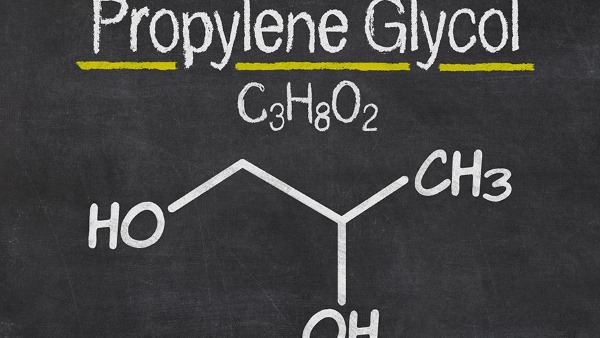
Propylene glycol is extracted from oil by chemical refining. It has bactericidal properties - it allows useful substances to penetrate into the deepest layers of the skin and prevents harmful bacteria from multiplying in cosmetics. Yet only this substance can bind fat-and water-soluble substances together. Propylene glycol leaves skin hydrated and radiant.
Glycerin is a substance obtained from vegetable fats. Its main task is to moisturize the skin and increase the water content in cells. In cosmetics, synthetic glycerin is most often used.
The main problem with this product is that it moisturizes the skin only when the air humidity is high. And if the air is dry, then glycerin, on the contrary, dries up the skin. Some cosmetologists talk about the dangers of glycerin, as it draws moisture from the lower layers of the epidermis to the upper ones, thereby drying out and aging the skin.
Silicones
Silicones are substances that do not mix with water. Used in all cosmetic products. Cosmetics manufacturers talk about deep hydration of the skin and sealing of moisture in cells, but this is not the case. Silicones do not affect skin moisture in any way, unlike natural oils.
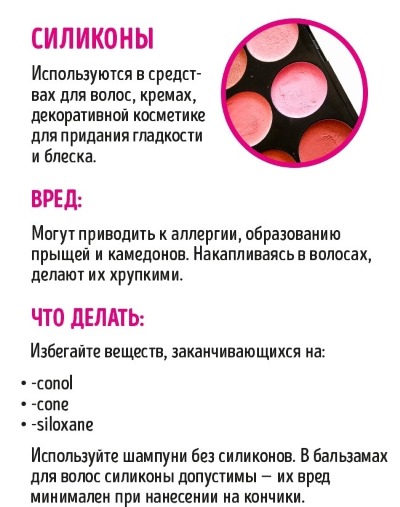
These substances, on the contrary, prevent the penetration of moisture into the cells.
And if a person's skin is already too dehydrated, then the feeling of dryness will only increase.
Forming a film on the skin, these substances leave all the dirt, sebum and dead cells on the face, preventing them from being washed off.
Because of this, skin diseases can often occur - acne, dermatitis, etc.
If, before applying other cosmetic products, apply a cream with silicone to the skin, then the remaining creams and serums will not automatically enter the dermis cells and their effectiveness will become almost zero.
More silicones are very difficult to remove from the skin surface, water will definitely not wash them away, and not all special cosmetics removers will cope with them. As a result, the skin becomes dirty and clogged.
Preservatives in cosmetics
A preservative is a substance that provides long-term storage of the product. Thanks to such substances, harmful bacteria and microorganisms do not start in cosmetics. Scientists every year try to check their safety for the body. Preservatives are also included in cosmetics.
There are two types of preservatives in cosmetics - natural and artificial. Naturally, natural preservatives do almost no harm, except for allergies in some cases, which cannot be said about artificial ones.

Research has proven that preservatives can lead to the following problems:
- Dermatitis.
- Hives.
- Itching.
- Peeling.
- Redness.
- Burning skin, etc.
Formaldehyde is the most popular preservative known. EU countries have banned the use of phomaldehyde in cosmetics above 0.2%. It is used in nail varnishes, shampoos, creams, balms, eyeliners, etc.
Thimerosal is a preservative containing mercury in its composition. Has antiseptic properties. Prolonged use can lead to body poisoning. It is often found in mascara.
Triclosan is an agent that prevents the appearance of fungus in cosmetics. According to research, it disrupts the balance of hormones in the body, destroys the immune system and provokes the occurrence of thyroid cancer. Often used in shower gels and toothpastes.
Vitamins
In the composition of cosmetics, which can be checked by packaging, not only harmful substances are often used, but also natural components or vitamins.
Many of them have a beneficial effect on the skin:
- Vitamin A - Most often used in anti-aging cosmetics. It can penetrate into the deep layers of the skin and nourish them. This vitamin has a stimulating effect on the cells that produce collagen and elastin, thus making the skin firmer and smoother. The aging process of the skin slows down.
But cosmetics with vitamin A are not recommended for use earlier than 40 years, since the efficiency will be small. Pure vitamin A should not be applied to the face. It can lead to severe allergic skin reactions.
- Vitamin E - another vitamin that helps to eliminate wrinkles and smooth the skin. It is used in anti-aging serums, creams and emulsions. Vitamin E lengthens the life of erythrocytes in the skin, brightens age spots, and helps to eliminate acne.
Vitamin E is also used in face creams due to its ability to remove excess moisture from the skin. So it prevents swelling and swelling.
- Vitamin C - cleans the skin from premature aging and the negative effects of ultraviolet radiation. It removes fine wrinkles and skin pigmentation on the face and neck, improves collagen production in cells.
- B vitamins - they all regulate metabolic processes in the dermis. They have regenerating properties, heal wounds from acne and blackheads, lighten age spots, remove skin redness and sunburn. B vitamins also enhance collagen production, moisturize the skin and are quickly absorbed.
Flavors
Fragrances are chemicals used in cosmetology to enhance the fragrance of cosmetic products and give them a pleasant aroma.
Fragrances are recognized as one of the 5 most common allergens among consumers. Because of their use, 65% of consumers experience contact dermatitis. Dermatologists also point out that fragrances can often cause rashes, skin redness and itching.
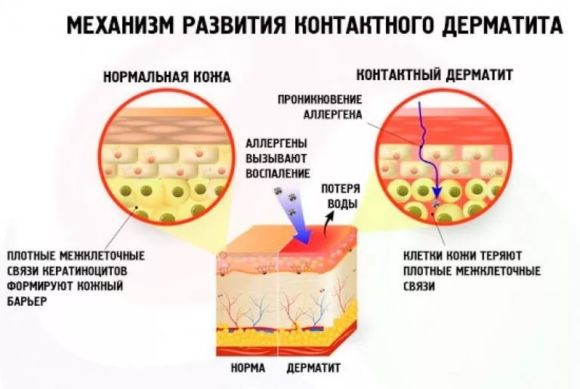
There are several types of flavors:
- A mixture of fragrances (fragrance mix I, FM I). This mixture consists of more than ten different components. So, one of the components - oak ha extract, is the strongest allergen. Studies have shown that regular use of cosmetics with this mixture of fragrances in the composition can lead to the development of dermatitis after a few months.
- Linalool - used in perfumes to give them floral notes. Almost all shower gels and shampoos contain linalool. When interacting with fatty acids, it gives an allergic reaction.
- Limonen - as the name implies, it is a synthetic fragrance with a lemon scent. It is used in perfumery and cosmetology. It is not highly carcinogenic and causes allergies, as well as natural citruses. Relatively safe.
- Citronellol - a flavoring agent used to create floral and fruity scents. Its concentration in cosmetics is very low, but in the EU it is prohibited for use in cosmetics due to its high allergenicity.
Surfactants (surfactants)
Surfactants - Chemicals used for cleansing in shampoos, makeup removers. Surfactants wash away the protective layer from the skin and make it dry and irritated.
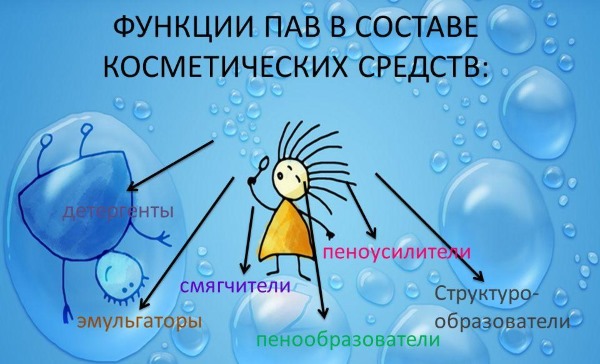
Types of surfactants:
- Anionic.
- Cationic.
- Ampholytic.
- Non-ionic.
Most surfactants are chemicals that negatively affect the skin, but there are also natural surfactants that do not harm humans:
- Coconut milk.
- Palmitic acid.
Synthetic surfactants in small doses do not harm humans, but if their content in the product is exceeded, then they can lead to liver, kidney and central nervous system problems.
SPF-filters
SPF-filters - elements used in the creation of sunscreen cosmetics. Cosmetics SPF protects the skin only from UVB rays.
Filters are:
- Chemicallye (absorb ultraviolet radiation).
- Physical (reflects rays before they hit the skin).
Both do not protect the skin from ultraviolet radiation, but only reduce the effect. Physical filters include zinc dioxide. It does not cause allergies in the consumer, but it can cover the skin with a light film. It can also be harmful to damaged cells, wounds and burns. It is often used in decorative sunscreen cosmetics.
Chemical filters are stronger than physical filters, but also more dangerous:
- Benzophenone-3
- Tinosorb S
They can penetrate skin cells, cause allergies and disrupt the endocrine system.
Parabens
The main task of parabens is to preserve cosmetics and protect them from harmful bacteria and microorganisms. These chemicals are used in all cosmetics.
Here are some of them:
- Isopropyl.
- Isobutyl.
- Butylparaben.
- Propylparaben.
The plus of parabens is their non-allergenicity, but their natural substitutes can cause allergic reactions. Until now, the harm of parabens has not been proven, it was believed that they lead to hormonal disruptions and breast cancer, but this has not been proven.
Dyes
Dyes are used in all decorative cosmetics. They impregnate the substance and completely color it.
There are several types of dyes:
- Organic.
- Inorganic.
- Vegetable.
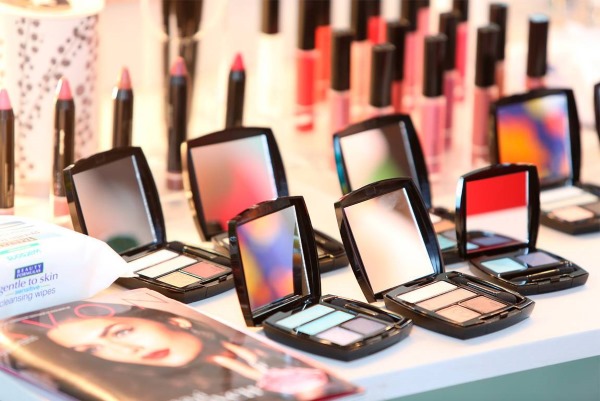
Plant dyes include dyes obtained from plants, flowers, fruits, etc.Inorganic dyes include: zinc oxide, iron oxide, mica, etc. Most of these dyes are used for hair coloring, eye cosmetics. The main danger of dyes is an allergic reaction. But the percentage of allergy sufferers to dyes is quite low.
Allergenic components in cosmetics
Often, consumers buying cosmetics cannot use them due to an allergic reaction. Allergy to cosmetics can manifest itself in different ways - it can be itching, redness, irritation of the mucous membranes, rash, acne, etc. Calculating the allergenic component can be difficult.
Vaseline and liquid petroleum jelly
Vaseline is a petroleum product. It is used in cosmetics to protect the skin and to retain moisture in it. Vaseline is included in almost every makeup composition. It is very easy to check it - you just need to look into the composition. It is used in hand creams, lipsticks, lip balms, nourishing ointments, etc.
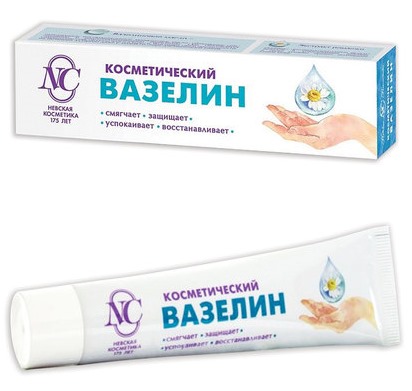
In theory, purified petroleum jelly should not contain any harmful substances. It is believed that petroleum jelly causes the growth of cancerous tumors, but this has not been proven. Vaseline also protects the skin from damage in frosty weather. There is a special cosmetic petroleum jelly sold in pure form or with additives.
Talc
Talc is a mineral supplement often used in cosmetology. It is applied in powders as a masking agent for imperfections of the skin, it is a binding ingredient of certain substances in creams or powders, makes the product creamy in texture and removes the stickiness of the skin.
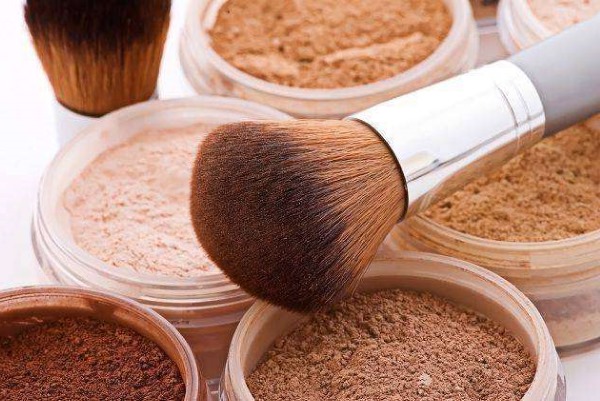
Talc used to be considered a carcinogen. It was said that it could lead to lung cancer if it enters the respiratory tract and ovarian cancer. Talc was also thought to clog pores and contribute to skin conditions. But talcum powder cannot clog pores due to its structure, besides, it is an absolutely natural mineral product. Allergy to talcum powder is very rare.
Propylene glycol
Propylene glycol is a substance used as a humectant. In cosmetics, it is used in solid deodorants to keep them in shape.
With everyday use of cosmetics with propylene glycol in the composition, allergic dermatitis may occur. It is toxic and aggravates the skin condition, causing acne and acne breakouts. A less toxic alternative to this substance is glycerin.
Antibacterial substance (Methylchoroisothiazolinone)
Antibacterial agent used in shower gels, intimate hygiene products, shampoos etc. Irritates skin even in minimal amounts and destroys nerve cells due to its neurotoxicity.
Alpha hydroxy acids
Alpha hydroxy acids are acids obtained from dairy products and fruits. They are popular due to their ability to rejuvenate the skin., remove damage caused by ultraviolet rays and fine wrinkles.
They also increase collagen production. ANA are used in face creams, anti-aging serums, face masks. The only contraindications will be individual intolerance to such acids and increased skin sensitivity.
Bura
Borax is a chemical also known as sodium tetraborate. Has antiseptic and softening properties. In cosmetics, it is used in lotions, shower gels, shampoos, powders, etc. Also used in pure form as a face mask.
Borax is very dangerous to get inside., because the substance is toxic. May disrupt kidney and liver function. Does not cause allergies.
Pigments of red color D&C Red No. 27, 40 and 9
These colorants are used in hair dyes, creams and masks. Are carcinogenic. It has a negative effect on the skin, contributes to the development of skin diseases and clogging of pores.
Lanolin
Lanolin is a natural wax obtained from sheep's wool. Well nourishes and protects the skin. In cosmetology, it is used in hand creams, face creams, moisturizing lip balms, lotions, etc. Protects the skin from adverse factors and penetrates deep into the dermis.
Since this is an animal product, it can be an allergen. Also, when used on oily skin, it can clog pores and lead to acne.
DMDM Hydatoin
Used in cosmetics as a preservative. This chemical component ensures the safety of the product and its antibacteriality. Serious allergen, can cause irritation of mucous membranes in humans, affects the skin.
Isopropylmyristate
Used in face creams and lotions. Has a softening effect on the skin, is used as a binder in creams and perfectly fixes pigments. Absorbs quickly into the skin and clogs up dirt, sweat and dead skin cells, because of this, irritation is often formed on the face.
Toxic components in cosmetics
Often, substances with toxic properties are used in cosmetics. If you use such cosmetics for a long period of time, then some organs and internal systems may malfunction. That is why frequent use of such funds should be avoided.
Methylisothiazolinone (MIT)
Substance of chemical origin used in decorative cosmetics as a disinfectant. It is included in shower gels, shampoos, scrubs, foams for washing, etc.

May cause an allergic reaction. Scientists have conducted research on the negative effects MIT on brain cells.
Triclosan
This substance is used in cosmetics as antibacterial. It prevents the growth of bacteria and microorganisms in an open medium and slows down their growth. In cosmetology, it is used in soaps, hand creams, gels, and toothpastes. It can provoke an allergic reaction, disrupt the hormonal state of the body or lead to skin irritation.
Triethanolamine
This chemical is used in cosmetics to raise the level pH... It is toxic and harmful to the skin and dangerous if swallowed. Triethanolamine added to sunscreen and eye cosmetics.
Sodium Lauryl Sulfate (SLS)
A component derived from coconut oil by refining. It is used in cosmetics: shampoos, gels for washing, scrubs, intimate hygiene products.
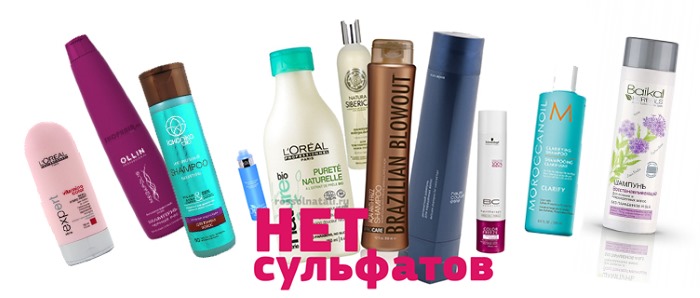
A rather dangerous component that negatively affects the skin. On contact with hair or dermis, it turns into a thin film. Because of this, skin irritation occurs, hair begins to fall out, dandruff appears, and the skin experiences discomfort and flakes.
Sodium Laureth Sulfate (SLES)
A substandard cleaner used in shampoos and scalp products. Creates a thick lather. SLES leads to irritation of hair follicles, dandruff, hair loss. More SLES is a nitrate that penetrates into the scalp. Studies have shown that frequent consumption affects vision.
Carcinogenic components in cosmetics
Carcinogens are dangerous chemicals found in cosmetics. They contribute to the development of tumors in the human body. Many cosmetics manufacturers use carcinogens in their products. And although their number in cosmetics is very small, they can accumulate in the body. This proves once again that the composition is very important and needs to be checked.
 Diethanolamine (DEA)
Diethanolamine (DEA)
An element used in cosmetics for the formation of foam. It is often found in shampoos, balms, foams, etc.
In pure form DEA neutral, but can react with many other components of cosmetics.
The result is a dangerous compound that promotes the growth of cancer cells.
Butylated Hydroxytoluene (BHT)
It is an antioxidant used in cosmetics to preserve it and to prevent the growth of microorganisms.
It is used in many cosmetic products of famous brands such as Dior, MAC, Dove, Rexona... Also BHT prevents the oxidation of fats in the product. It is a carcinogen, causes allergic reactions and accumulates in the cells of the dermis.
Trithanolamine (TEM)
It is a strong alkali used as pH regulator. In cosmetics, it is a part of body milk, sunscreen cosmetics, shadows, blush, eyeliners, etc. Studies have been carried out, as a result of which it has been proven that the use of a cream with TEA led to the development of allergic dermatitis. Can be used infrequently and rinse with water after use.
Salicylic Acid (BHA, Beta Hydroxy Acid)
Salicylic acid is a component of willow bark and has antiseptic properties. Penetrates into the deep layers of the skin, regulates the sebaceous glands and accelerates cell regeneration. In cosmetology, it is used to treat acne, acne, warts and inflammatory skin processes.
It is necessary to correctly calculate the dose of acid, as if used incorrectly, it can lead to dry skin and its irritation, and even a burn.
With frequent skin exposure to ultraviolet light, it develops cancer cells.
Monoethanolamine (MEA)
The chemical absorbent washes away the protective layer of the skin and makes it vulnerable to harmful environmental influences. Because of this, skin cells can also become cancerous.It is used in shower gels, foams, scrubs.
Butylated Yedroxytolune (VNT)
A preservative that replaces natural vitamin E. It is an antioxidant that prevents the oxidation of creams. It is included in body oils, gloss, lipsticks, creams, liquid shadows. Can accumulate in the skin and cause cancer.
Natural cosmetic
Natural cosmetics manufacturers claim that they are free of antioxidants, carcinogens, chemical dyes, petroleum-derived products, etc. But is it?
Natural cosmetics can be used:
- Extracts from plants, essential oils
- Chemically altered plant constituents
- Mineral elements
- Synthetic preservatives
But natural cosmetics also contain many chemicals. For example, natural cosmetics also use chemical preservatives and antiseptics. After all, the shelf life of such cosmetics is no less than that of ordinary ones. Often used in natural shampoos and foams SLES, which is a nitrate.
The mineral oils in such cosmetics are refined petroleum products. Due to such a component, allergic reactions and skin diseases can occur. You can also find formaldehyde, amaranth, petroleum jelly, glycerin, aluminum salts, etc. in cosmetics made from natural ingredients.
Every cosmetic product contains substances of chemical origin. At least one component will be dangerous to the body.You need to pay attention to the composition of cosmetics. So you can find out the amount of harmful components and check the safety of the product.
There is no absolutely safe cosmetics, but there is one that is neutral for our body. Viewing the composition will avoid many health problems.
Article design:Natalie Podolskaya
Video about the composition of cosmetics
Video on how to check the composition of cosmetics:

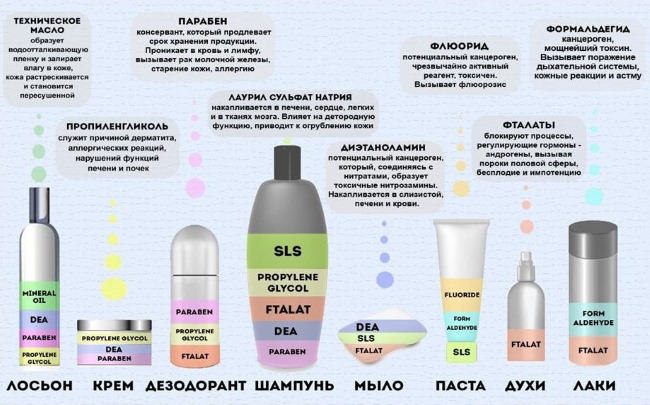
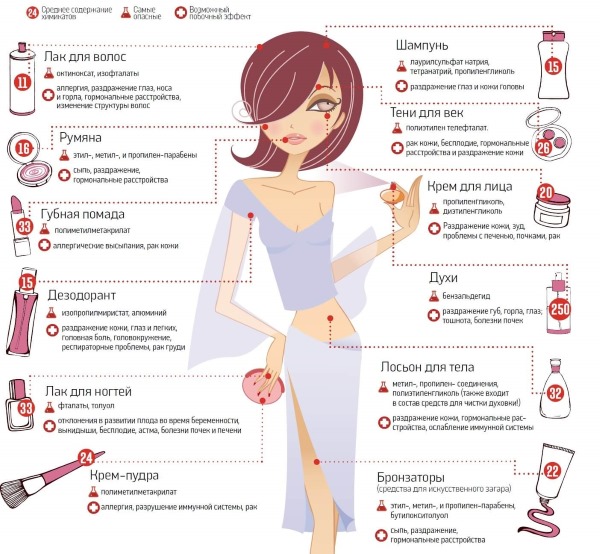
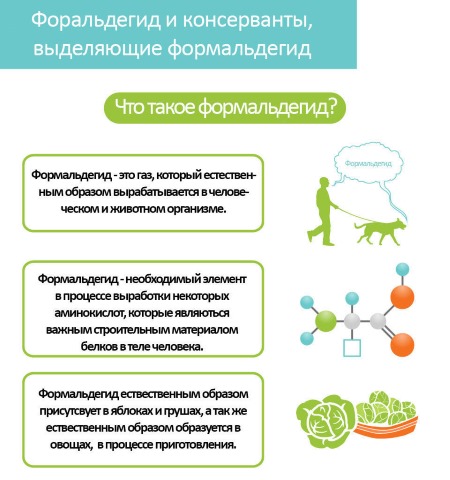
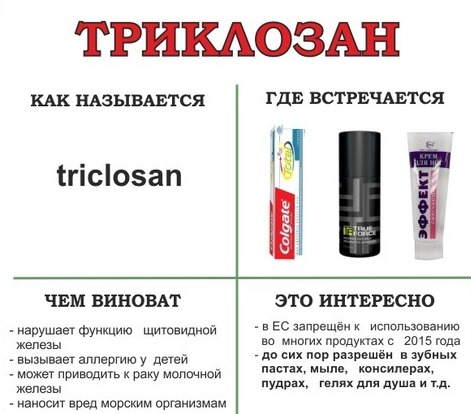
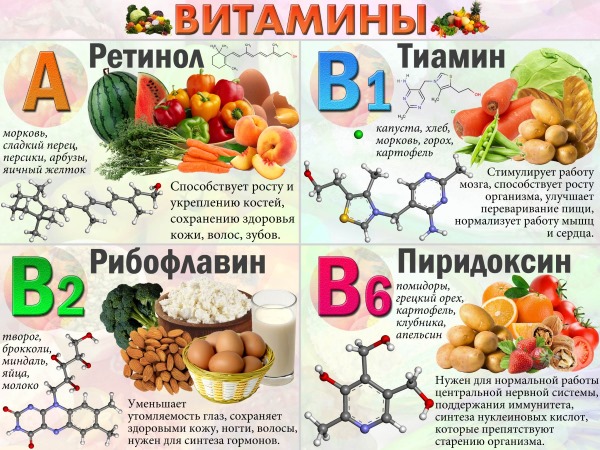
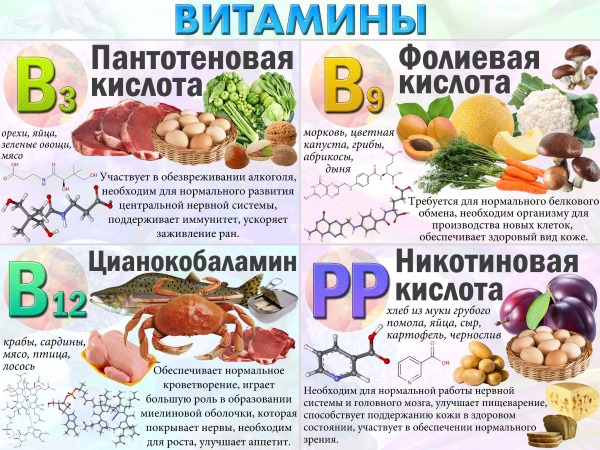
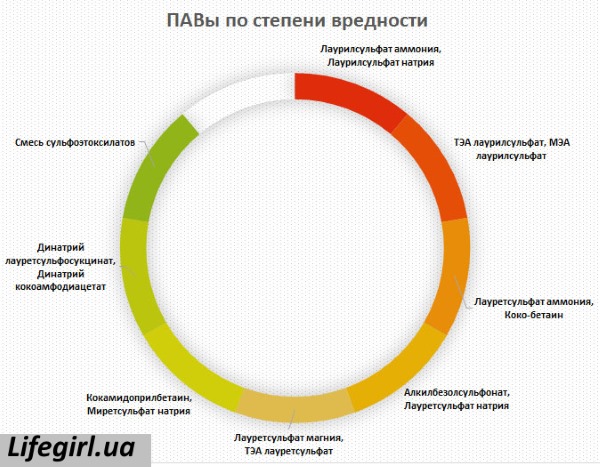


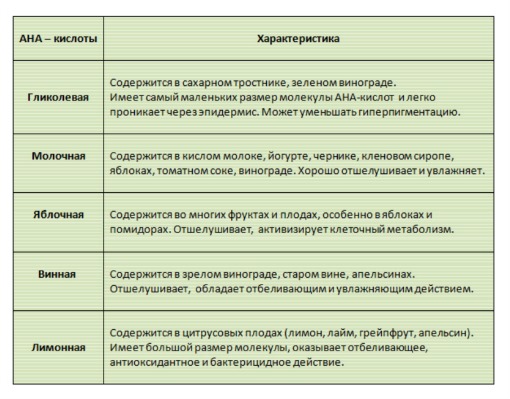
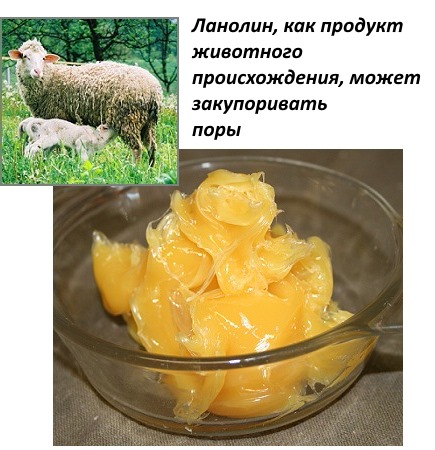

I always carefully read the composition of cosmetics that I buy, especially for children. Still, health care should come first.
There is a lot of unreliable information. I advise you to read the primary sources. Not articles from questionable women's magazines.